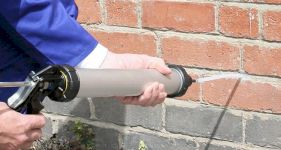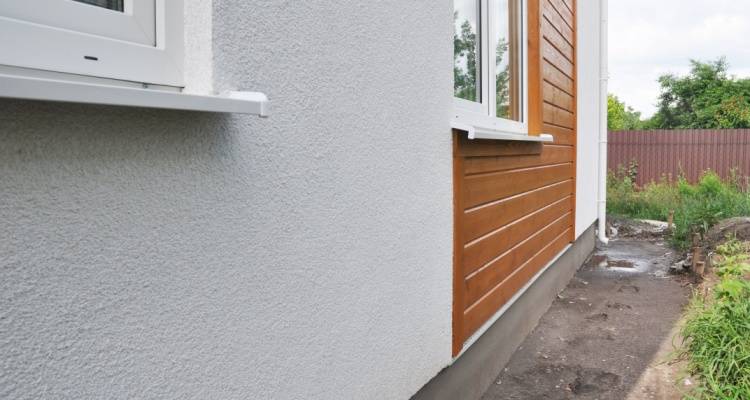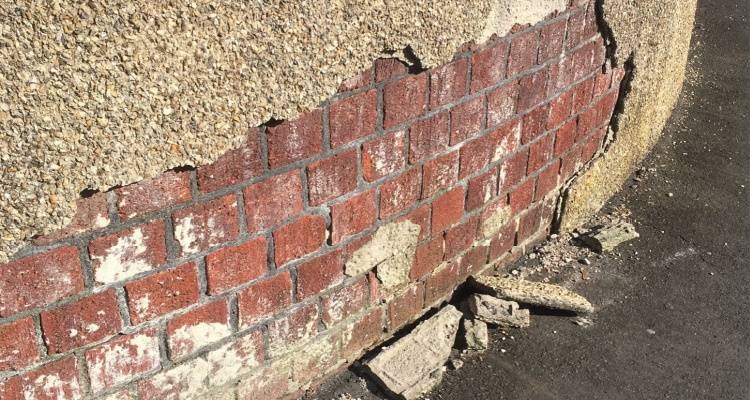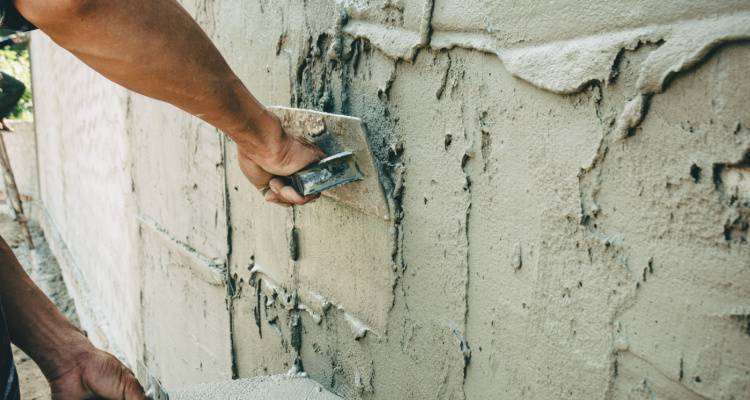Silicone Render Cost
- The average cost of silicone rendering is £50 per m²
- For an average semi-detached house of around 200m² the total cost will be in the region of £10,000
- An overview of silicone rendering and its costs
- Hidden costs, labour charges, and supply costs associated with silicone rendering
- Additional considerations for your silicone rendering project
Silicone render is amongst the easiest external property coatings to apply, needing just one coat and requiring little-to-no maintenance owing to its hydrophobic properties. But, these advantages come at a price - silicone render is a premium product, making it one of the more expensive options on the market.
Despite the increased cost, silicone render is growing in popularity in the UK due to its durability, flexibility and crack resistance when compared to cement render. Available in a range of finishes, if applied correctly, silicone render can last for 30 years without intervention.
To find out more about the cost of silicone render, including labour, supply and hidden fees, keep reading.
We can also get your quotes from silicone render contractors in your area.
£10,000
Table of Contents
- How Much is Silicone Rendering?
- Supply Costs
- Additional Costs
- Labour Costs and Timescales
- Cost Factors for Silicone Rendering
- Types of Silicone Rendering Finishes
- Alternative Types of Silicone Rendering
- Removing Existing Rendering: Considerations and Costs
- Building Regulations Related to Silicone Rendering
- Hiring Contractors Checklist for Silicone Rendering
- FAQs
- Sources
How Much is Silicone Rendering?
The average cost of silicone render can range from £45 to £55 per m² for supply costs only. The average cost of silicone render application on a 200m² semi-detached house is between £9,000 to £11,000, and a 300m² detached house can cost between £13,500 to £16,500.
The bigger your house, the higher your render price - and geographical considerations also play a part in raising or lowering your supply and labour charges, with cities commanding higher fees than towns. It’s important to bear this in mind when collecting quotes from tradesmen as you are likely to see a bigger spread in costs if you live in London.
Scaffolding
Most silicone render jobs require scaffolding for safe access to exterior walls. Scaffolding is likely to cost between £750 to £900 to fit a semi-detached house for painting or plastering access, with the cost rising to £900 to £1,150 for a detached property.
This is for a 1-week hire period, and prices can fluctuate based on your location and the period of your hire. These costs are typically included in your quote rather than charged separately.
Silicone Rendering Prices
These costs include both materials and labour.
| Property Type | Estimated Cost | Time Required |
|---|---|---|
| 2-bed bungalow (100m²) | £4,500-£5,500 | 1 to 2 days |
| 3-bed semi-detached (200m²) | £9,000-£11,000 | 1 to 2 days |
| 4-bed detached (300m²) | £13,500-£16,500 | 2 to 3 days |
Supply Costs
Silicone render cost per m² is between £45 to £55, with a 25kg supply costing £80, which covers roughly 9–10m2. To lay this correctly, your contractor will need the following supplies:
| Item | Cost |
|---|---|
| Basecoat (or scratch coat) | £3.50 per m² |
| Fibreglass mesh | £1.50 per m² |
| Topcoat | £5.50 per m² |
| Beading | £3 per m² |
As contractors can take advantage of bulk buying discounts, it’s a good idea to ask if they can include supplies in their quote so that you can benefit from those savings, instead of buying items individually at their full price.
Additional Costs
Waste Disposal and Skip Hire
If you’re having your property’s old rendering removed, you will need a skip. Mini skips are around £90, while the largest skips can cost closer to £800.
Large skips are most suited to rendering projects, especially if your house is detached, or has rendering applied to all sides of the property. A 20-yard skip will cost between £300 to £600, with a 40-yard costing between £400 to £800.
Costs in London are expected to be between £50 to £350 higher than in other locations, such as the North of the UK, due to increased demand. You will need to ensure that your skip is suitable for the type of waste you will be producing, as incorrect labelling can lead to fines.
Permits
You’ll need to check with your local council to see if you need a permit for your skip hire if you plan to leave it on the roadside, which can range from £10 to £70 depending on your location. You can face fines of £1,000 if you don’t get a permit before having your skip delivered if you’re storing it on the roadside.
Labour Costs and Timescales
Silicone render application is not something to attempt as a DIY project - you need to hire rendering specialists to ensure the job is completed to a high standard to avoid the coating failing due to improper application, which will only end up costing you more in the long run to fix.
Rendering specialists cost in the region of £130 to £250 per day, with fees rising in line with the contractor’s skill level. However, with this added cost, you can glean discounts in other areas of your project, such as with supply costs.
Tradesmen have greater buying power in the construction industry, meaning they can take advantage of bulk buy prices - cheaper than what you can get when buying items individually in-store. This can also mean that some of the project management is taken care of as you don’t have to collect the items yourself.
Cost Factors for Silicone Rendering
Location and Ease of Access
Unfortunately, we’re beginning with a non-negotiable - the geographical area your property is located in. Costs for the same job in London will be higher than in the North of the UK, due to demand and supply prices.
What’s more, if your property doesn’t have off-road parking or a driveway, you will most likely need to order a permit for your skip hire to store it on the roadside during your project. Permits can range from £10 to £70, and you can face fines of £1,000 if you don’t have one and you choose to store your skip on the road.
If your property overhangs a public pavement or road or is particularly tall, your prices are likely to increase as the ease of access for the contractor is reduced. Additional scaffolding hire and the potential for temporary closure of public rights of way can impact your costs, making the job even more expensive.
These costs can vary depending on your county, so it’s best to check with your local council for your rates and then budget accordingly.
Condition of Substrate
It’s possible that your substrate may have become damaged during the removal of old rendering - especially pebbledash, as the rough detachment style can lead to masonry being negatively impacted. You will need to pay for the restoration of any such defect, which can range from £100 to £350 for small patch repairs.
Types of Silicone Rendering Finishes
Silicone rendering is often seen with a smooth, sleek finish, giving properties a contemporary look and feel. Depending on your choice of silicone render finish, your application price may vary - the more ornate and detailed the application, the higher the labour charges and therefore your overall project cost.
There are several silicone render colours to choose from, ranging from neutrals to more bold shades. When choosing your silicone render colour, you need to be aware of any restrictive covenants in your area that may prevent you from colouring your house in a hue that’s different to the houses around you.
The more off-the-shelf the colour is, the lower your cost will be when comparing prices with bespoke shades. If you’re looking to keep well within budget, opt for a pre-mixed colour instead of having something individually made for you.
Alternative Types of Silicone Rendering
You may not have your mind completely made up on what sort of external coating you want on your property - and in this section, we’ll walk you through a few of the alternatives to silicone rendering for you to consider.
Render Over Existing Render
A common choice to keep costs down is to simply render over the existing render. This is only possible where the original rendering is in good condition and shows no sign of failure.
If you apply new rendering without assessing the existing structure, you risk having both layers falling off, leading to health and safety issues and added repair costs. If you have minor issues such as cracks, your contractor will repair these before starting work, with small patch repairs usually costing £100 to £350.
This method is more time-efficient than full removal and can help trim down labour charges and hire charges for additional equipment. Render applications start at £3,000 for small properties and rise to £6,000 and above for larger homes.
Cement render is the cheapest at £10 per m2, while lime render costs around £20 per m2. When you start adding plastics, the price rises, with polymer render costing around £30 per m2.
Clad Over Existing Render
If your underlying rendering is in good condition, you can install cladding over your rendering. Cladding installation costs around £3,800 and takes two to three days, making it more time-efficient than removal - especially true if you have pebbledash rendering, which commands long labour periods due to removal difficulty.
Your cladding material - timber, UPVC or aluminium - will give you lower or higher costs, with timber being cheapest and aluminium most expensive.
Paint Over Existing Render
You can paint over your existing render if your contractor deems full removal unnecessary. Your contractor will examine the original rendering for damages or structural decay and fix minor problems.
Any dents or missing spots will become obvious once masonry paint is applied, so this repair step mustn't be skipped. Painting works better for some surfaces than others, and won't cover unwanted textures like pebbledash.
Masonry paint costs £10 to £25 per m2 - equating to £800 to £2,000 supply costs for a two-bed semi-detached house. You'll need to add equipment costs and labour rates.
Different Types of Render
Here are some other types of render you may be interested in:
Removing Existing Rendering: Considerations and Costs
Unless your current rendering is in good condition, the chances are you will need it to be removed before you can apply your new silicone rendering. If there is substantial damage to the original layer - large cracks, loss of surface area, and signs of structural damage - then your contractor will advise that a full removal and re-application is the way forward.
Most commonly seen in the rendering market is the removal of pebbledash render as it is considered an antiquated style. This can cost anywhere between £2,100 to £7,800 and upwards, depending on your house size.
Starting with a blank canvas is the best practice, although it is the more expensive option when faced with the choice between simply rendering over the existing render or embarking on the labour-intensive task of removing it. Your contractor will need to pay special attention to the condition of your substrate, as any damages or defects will need to be taken care of before they can install your silicone render.
If you’re in any doubt, speak to your contractor about what’s best in your circumstances, with your budget in mind.
Building Regulations Related to Silicone Rendering
While you may consider the addition of silicone render as an aesthetic change to your property, there are building regulations to bear in mind. Alterations to a property’s exterior can have impacts on fire safety, structural stability and insulation, all of which fall under building regulations jurisdiction, so while silicone render application is likely to fall under permitted development, you may still need to have an assessment to confirm the proposed changes.
This is especially true if you are planning on removing old rendering and replacing it with silicone render as it may impact your home’s insulation. Your rendering specialist will need to consider both the U-value (thermal transmittance) and the reciprocal R-value (minimum thermal resistance) to calculate the need for additional insulation as a result of the change.
Before you start work on renovating your property’s exterior, you should check with your local planning authority or conservation officer to make sure you adhere to any relevant guidelines in your area.
Hiring Contractors Checklist for Silicone Rendering
Choosing your contractor is arguably the most important part of your project - let’s take a look at the key considerations to ensure you’re getting a qualified trader.
Qualifications, Licences And Insurance
Whatever the speciality, your contractor will need liability insurance - if for whatever reason they don’t have this and try to tell you that it’s not needed, do not engage with them as this is a risky practice and can lead to hefty payouts in the event of any accidents.
While there are no set qualifications needed for external rendering, general experience in plastering and rendering, as well as experience in handling hazardous materials can indicate an experienced contractor.
Read Reviews
While a contractor’s website can look professional at a glance, the real test lies in their customer reviews. Make sure you read the reviews from independent websites, such as Reviews.io and Trustpilot, to get an unfiltered opinion.
Take special note of any comments on the trader’s work ethic - including their communication skills, timekeeping and cleanliness - as well as if the reviewer would recommend their services. If there’s a collection of one-star reviews with repeated comments, it’s best to steer clear of that provider and find someone more suited.
Gather Multiple Quotes
With our last point in mind, it’s a good idea to gather several quotes. This will give you various prices and options, allowing you to compare offerings and pick the best contractor for your project.
Ensure all quotes are in written format, and are itemised, so you have something to fall back on if there are any payment discrepancies and what is and isn’t included during the project.
Hidden Costs
Be sure to ask any questions before signing on with a contractor - if skip hire is included, if any parking permits are needed, and who deals with the project’s waste - as doing so before the job starts will give you greater peace of mind when the time comes to start the project.
FAQs
What Is Silicone Render?
What Is the Best Silicone Render?
Which Climates Are The Best For Silicone Render?
Do I Need To Maintain Silicone Render?
Can I Make Repairs To Silicone Render?
Sources
https://greenoakcompany.co.uk/how-much-is-silicone-rendering-per-m2
https://ralphplastering.co.uk/is-silicone-render-any-good
https://www.fmb.org.uk/resource/house-render-what-you-need-to-know-before-you-start.html









